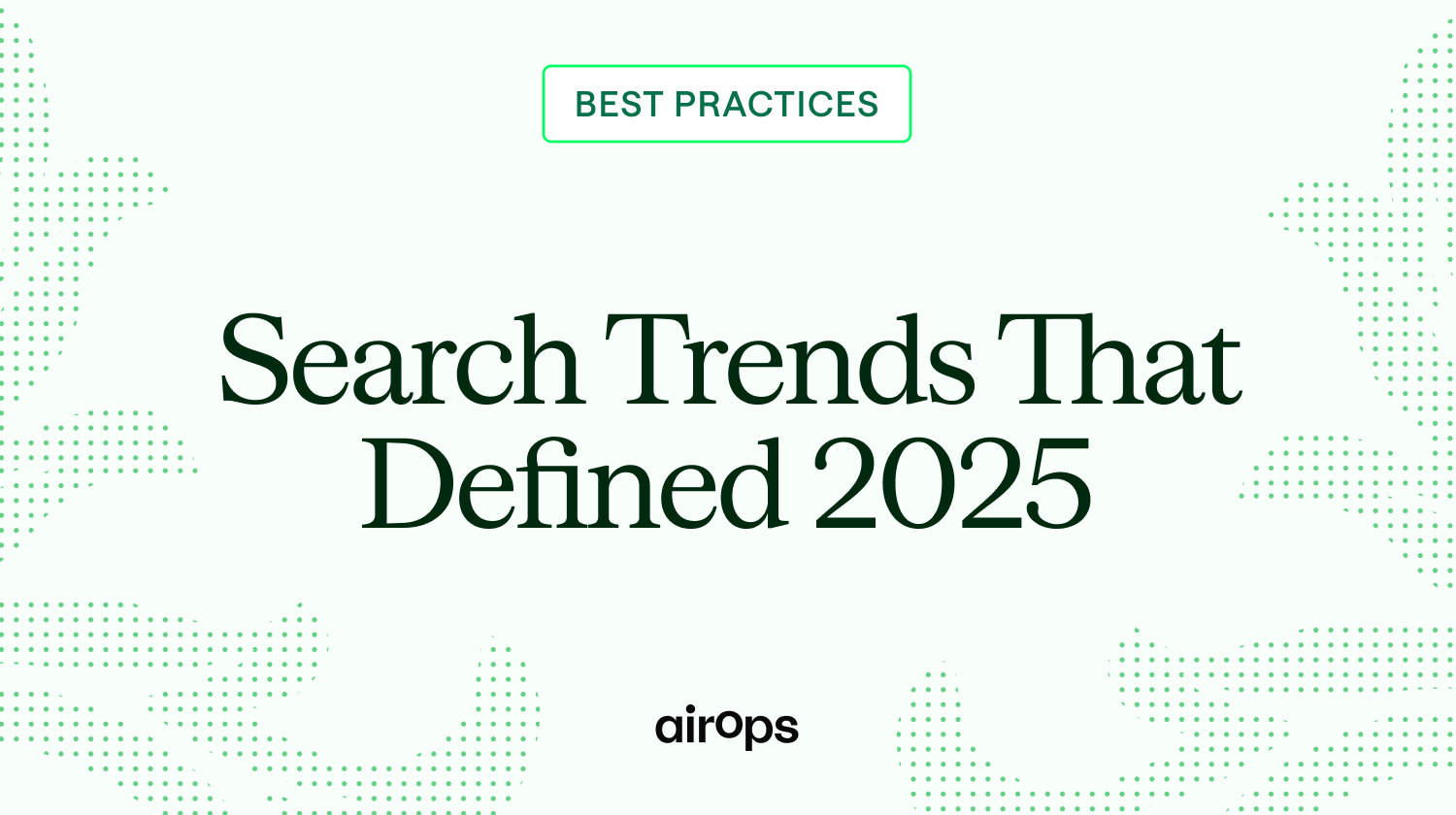Is Your Brand Ready for AI-Powered Growth? A Complete Diagnostic Guide
.avif)
In our previous article, "The New Rules of AI Content," we explored a fundamental split in the market: companies drowning in AI-generated fluff versus those building lasting advantages with value-first content.
The response was clear - everyone wants to be in the second category.
But here's the challenge: knowing you want to scale quality content is one thing.
Knowing if you're ready to scale is another entirely.
The Scale-Ready Mindset
Most companies approach AI content scaling backwards. They start with the tools, jump into production, and hope for results.
It's like trying to build a skyscraper without checking the foundation - impressive plans, shaky execution.
Instead, the winners in the AI-content era start with three critical questions:
- Where do we stand today? (Your current position)
- What can we actually execute? (Your realistic capabilities)
- Which scaling path matches both? (Your strategic fit)
Why Most AI Content Scaling Fails
Most companies' attempts at scaling content with AI fail, simply because they choose the wrong approach for their current position.
Common patterns we see:
- Companies trying to compete on high-competition terms without the proper foundation
- Brands attempting programmatic SEO without the necessary data infrastructure
- Teams implementing content refresh strategies without proper quality controls
- Organizations scaling editorial content without subject matter expertise
Choosing the wrong AI content scaling strategy can have severe and lasting consequences. Google's update earlier this year highlighted this by penalizing sites flooding search results with low-quality AI content, causing visibility drops of up to 40% and erasing years of SEO progress, like this:
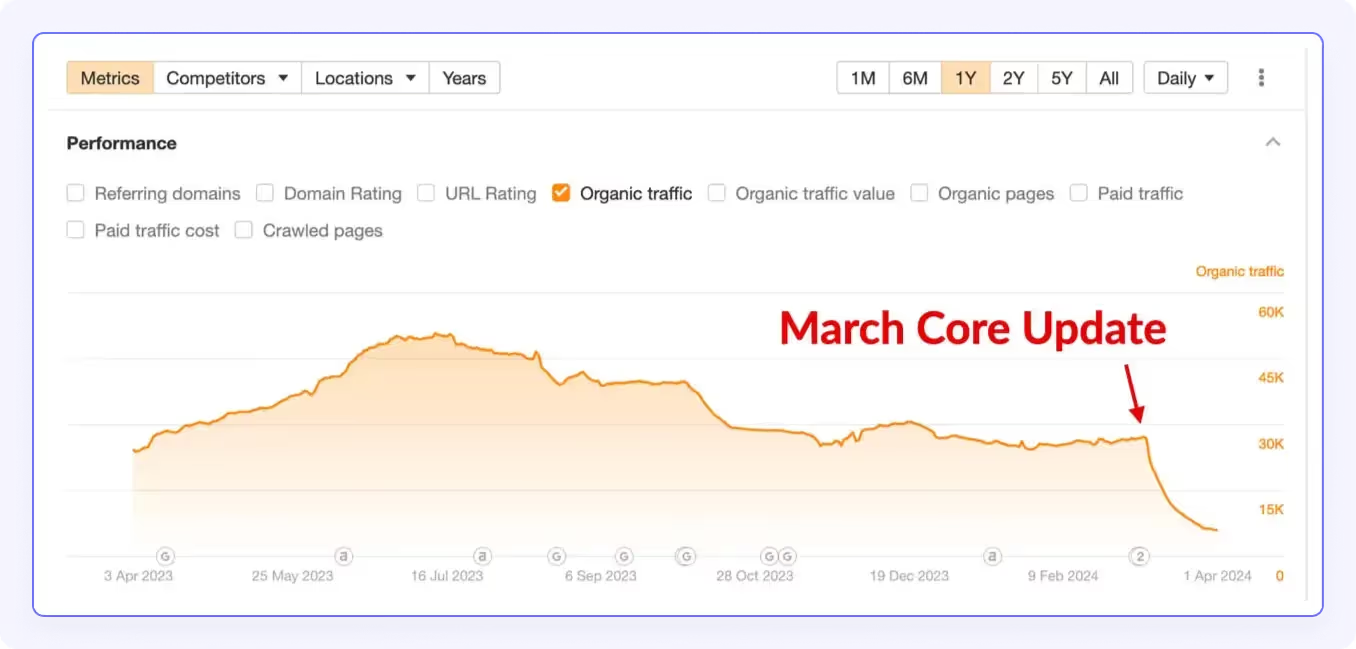
If you follow a thoughtful path to scaling SEO content with AI, you can avoid these pitfalls.
It starts with understanding your current situation.
Step 1: Analyze & Understand Your Current Metrics
Before diving into any scaling strategy, you need a clear picture of where you stand.
Let's break this down into two key areas: your brand's current position and your competitive context.
1. Understand Your Brand's Current Position: A Foundation for Growth
Your path to scalable growth starts with a critical metric: Domain Authority (DA).
At AirOps, we've identified DA 30 as the pivotal threshold where advanced scaling strategies are possible, and highly effective.
Before diving deeper, take stock of both your current DA score and examine your 6-month trajectory – this combination reveals not just where you stand, but where you're headed.
Building on this foundation, let's examine your organic performance metrics, which tell a more complete story:
- Start by calculating what percentage of your total traffic flows from organic search – this serves as your SEO foundation
- Layer in your month-over-month growth rates to identify emerging patterns
- Finally, analyze your ranking distribution, paying special attention to positions 1-3 (your current wins) and pages 2-3 (your immediate opportunities)
Now, to complete the picture, we'll assess your content health – the engine driving your organic growth:
- Begin by studying your current top-performing pages, as they hold valuable lessons about what resonates with your audience
- Next, map out your topic clusters and authority areas to identify where your true expertise lies
- Then, look within these core areas for content gaps that represent quick-win opportunities
To help you put all these pieces together, we've developed a free AI Growth Strategy tool.
The core of this is the Readiness Assessment, which synthesizes these key metrics into actionable insights, much like the components that make up Domain Authority itself.
This is Masterclass’s Readiness Assessment, as an example:
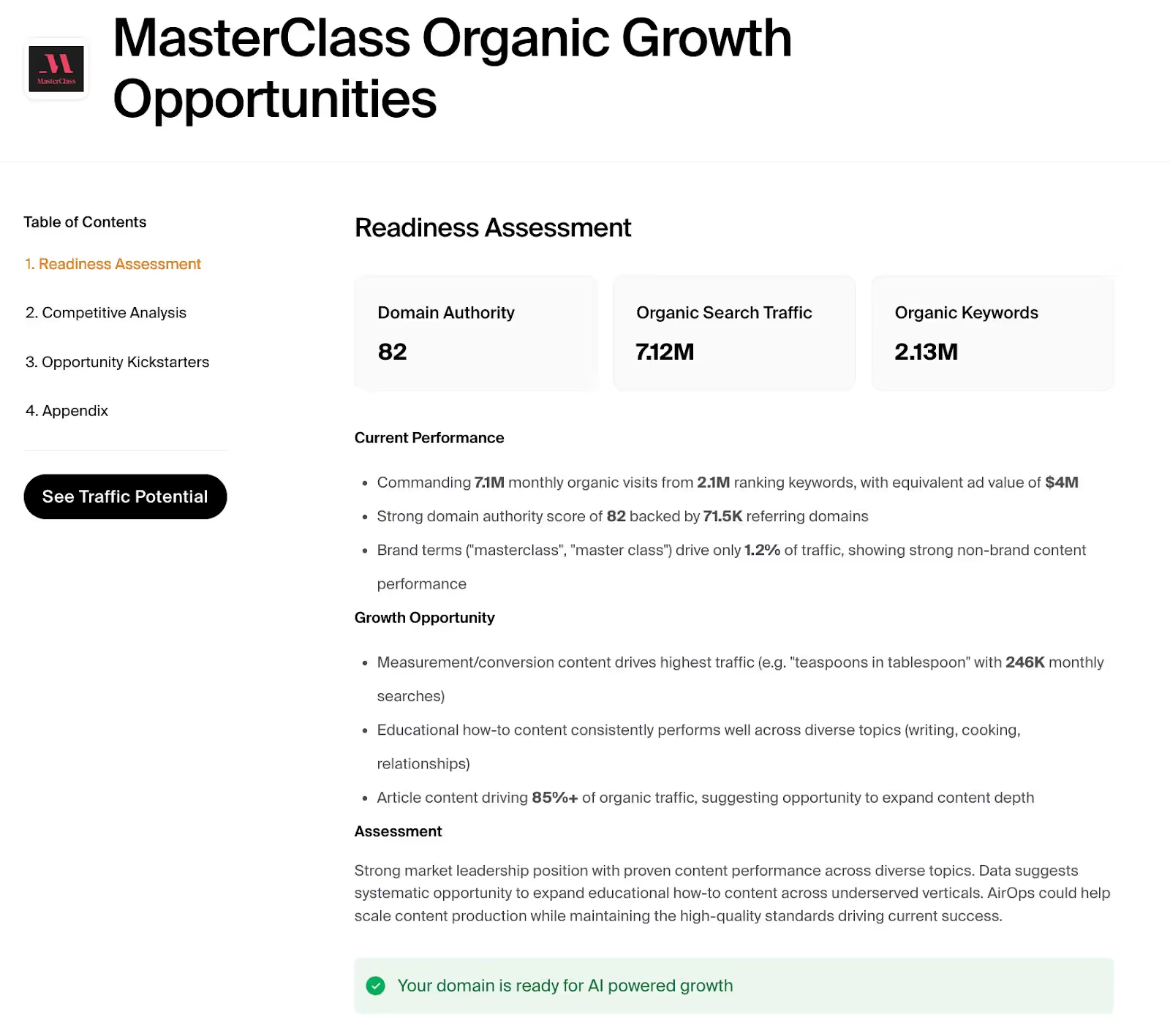
2. Analyzing the Competitive Context: Mapping Your Market Position
To build an effective growth strategy, you need to understand exactly where you stand relative to competitors.
This starts with a detailed analysis of Domain Authority gaps, which reveal both challenges and opportunities.
Compare your DA across three key dimensions:
- First, measure the distance between you and your industry leaders to understand the scope of growth needed
- Then, benchmark against direct competitors to identify near-term competitive advantages
- Finally, keep watch on emerging challengers who might disrupt your market position
This comprehensive competitive analysis becomes the cornerstone of your scaling strategy. By understanding these relationships clearly, you avoid common strategic missteps, such as prematurely targeting high-difficulty terms or overlooking valuable opportunities within your existing content library.
Take Supermetrics as an example – their competitive analysis reveals they rank 4th in organic search performance with 13,624 monthly organic visits, while market leader Fivetran.com demonstrates significantly stronger visibility.
Yet despite this competitive gap, analysis reveals significant untapped potential in the marketing analytics and data integration space, where keyword CPCs ranging from $14-30 indicate high commercial value.
This is an example of how competitive analysis can uncover valuable growth opportunities, even when you're competing against established category leaders – there's still substantial market opportunity to capture in the data connectivity and marketing analytics space.
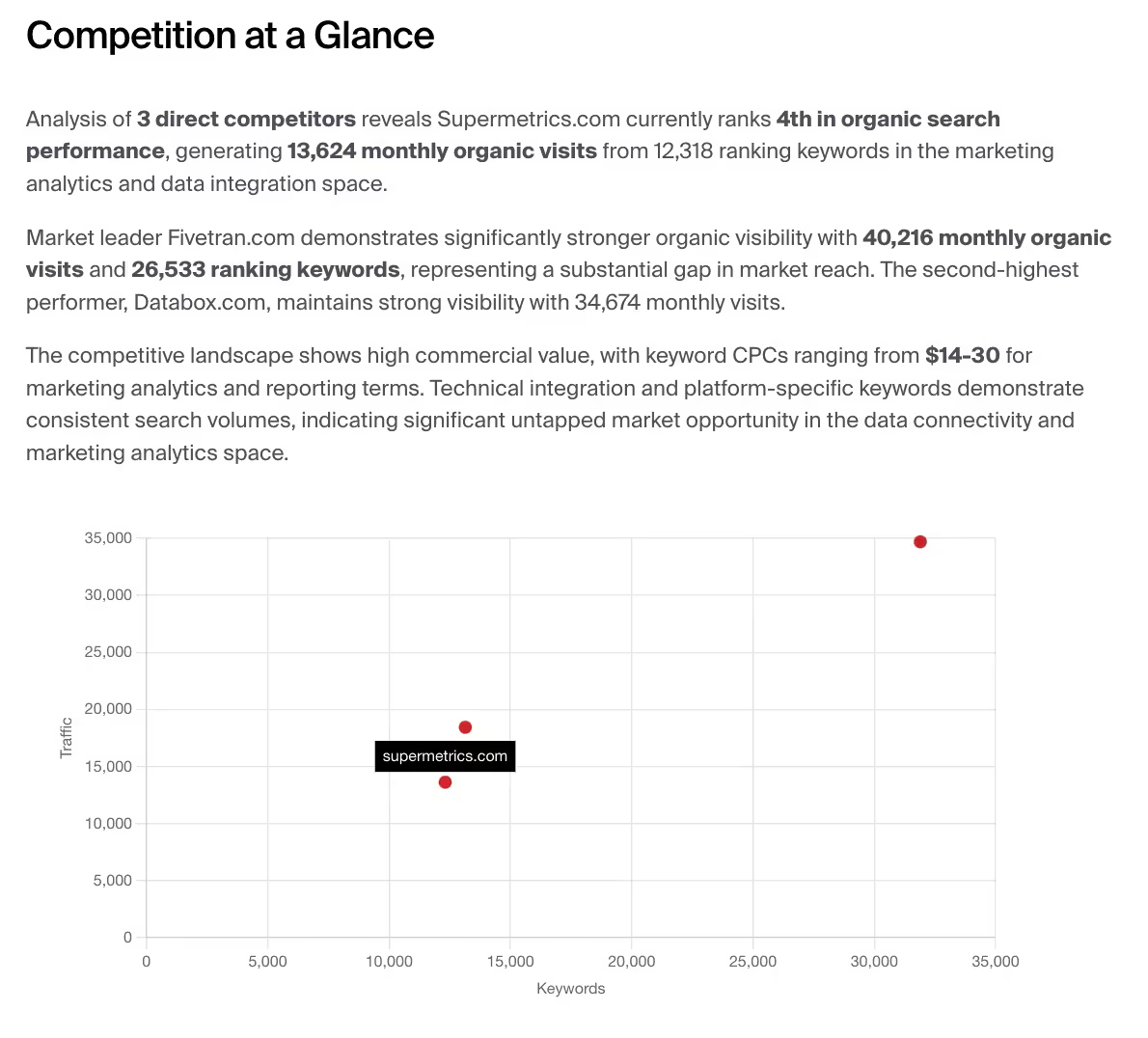
Note: get your free Custom AI Growth Strategy for free, here.
Step #2: How To Understand Your Scaling Options
Now that you have a clear picture of your metrics, the next step is choosing the right scaling strategy.
Your current position—whether you're leading or trailing in your market—will heavily influence which approach will work best for you.
There are a few questions you’ll need to answer to identify your best scaling option:
Question #1: What Are Your Internal Resources?
Three key factors based on your internal team resources will ultimately determine which scaling strategy makes sense:
- Technical Infrastructure: What your current tech stack can support
- Content Foundation: The quantity and quality of your existing content
- Team Capabilities: Your available expertise and resources
These factors map directly to three proven scaling strategies that successful companies use to grow their organic traffic with AI.
.avif)
Question #2: What Is The Competitive Context?
Your choice of scaling strategy will also depend heavily on your competitive position.
Here's how to approach scaling based on where you stand:
For Emerging Leaders (Trailing Position)
When you're building market presence, your strategy needs to balance rapid growth with smart resource allocation.
The most successful companies in this position focus on:
- Identifying specific content and Domain Authority gaps between you and market leaders
- Building momentum with achievable 6-12 month growth targets
- Moving quickly in underserved segments where competition is lower
- Leveraging AI to maintain consistent output while preserving quality
Key Takeaway: Even with larger competitors, there are always opportunities and white space opportunities to build authority in specific niches.
For Market Leaders (Leading Position)
When you're defending market share, your focus shifts to maintaining and expanding your advantage while protecting against emerging competitors.
Success requires:
- Systematic content updates to protect high-value rankings
- Quick expansion into adjacent topics where you can leverage existing authority
- Investment in content quality to maintain your expertise moat
- Strategic use of AI to scale while maintaining your quality standards
Key Takeaway: Leadership positions are maintained through systematic expansion and consistent quality. Use AI to amplify your existing advantages rather than trying to reinvent your approach.
Here is a decision tree to help you understand the ideal scaling options based on your Domain Authority, existing assets, and status in the market:
.avif)
Step 3: Decide How To Scale (The Domain Authority Decision Tree)
At AirOps, we've observed a clear pattern: Domain Authority of 30 or more consistently marks the dividing line between companies ready to scale their content operations and those who need to focus on building their foundation first.
At this level, your site has demonstrated enough authority that Google consistently indexes and ranks your content. You've proven you can create and maintain quality content that serves user needs.
If You Are Below DA 30: Build Your Foundation
If your site is still building its authority, building your foundation first is critical for long-term success.
While many companies rush to scale their content operations too quickly, our experience shows that those who invest time in building strong foundations consistently outperform in the long run.
Here are four proven strategies to help you build that foundation:
Foundational Strategy #1: Content Strategy and Ideation
Start by letting AI analyze your competitor's content landscape to uncover meaningful gaps in the market.
This analysis should be combined with a deep dive into your internal data and intellectual property to identify where your unique expertise intersects with untapped market needs.
Look specifically at your proprietary knowledge sources - customer support interactions, sales team insights, and product development learnings can all be transformed into unique content angles that your competitors can't replicate.
Key Focus Areas:
- Map your expertise against identified market gaps
- Document unique insights from internal teams
- Track customer questions and pain points
Foundational Strategy #2: SEO-Optimized Content Creation
Your content creation process should begin with low-competition, long-tail keywords that align with your expertise.
Use AI as your research assistant to develop comprehensive briefs, but keep expert oversight at the core of your creation process.
Each piece should be enriched with relevant data and context while maintaining your authentic voice and expertise. The key is to develop a systematic approach that scales quality without sacrificing depth.
Foundational Strategy #3: Technical SEO Enhancement
Technical excellence forms the backbone of your SEO success.
Implement a systematic approach to optimizing meta titles, descriptions, and schema markup across your site. Rather than trying to tackle everything at once, focus on creating automated processes that can identify and prioritize technical improvements.
This includes regular audits of your meta information, ensuring proper formatting across all pages, and maintaining consistent quality signals.
Your technical foundation should support both current content and future scaling:
- Establish clear metadata standards and templates
- Implement automated quality checks
- Monitor and optimize site performance metrics
Foundational Strategy #4: Internal Linking Structure
Think of your internal linking strategy as building a web of expertise. Each new piece of content should strengthen your topic clusters and reinforce your authority in key areas. Begin by mapping out your core topics and identifying natural connection points between related content.
The goal is to build topical authority through thoughtful content connections. Let your internal linking structure tell a cohesive story about your expertise, with each link serving as a deliberate step in your user's journey through related topics.
Beyond internal links, you can strengthen your Domain Authority through strategic external backlinks. Focus on building relationships with customers and partners who can provide relevant, high-quality backlinks to your content. Prioritize outreach to domains and sites within your industry that can validate your expertise and enhance your topical authority.
Implementation Approach
Start by implementing these strategies across 20% of your content to test and refine your approach.
Focus on your most promising topics and highest-impact opportunities first. Then monitor the results carefully and document what works - and what doesn't - before scaling to a broader implementation. This measured approach helps ensure that your growth in domain authority is built on a foundation of proven success.
At this stage, your goal isn't to create more content. Instead, focus on creating better content that establishes your authority and builds a foundation for future scaling.
If You Are Above DA 30: Scale Strategically Through 3 Paths
If your Domain Authority is 30+, the opportunities to grow with content expand significantly.
You can move beyond one-by-one content creation and begin implementing systematic approaches to growth.
Three proven strategies become viable:
- Programmatic SEO
- Content refresh
- Editorial scaling
Let’s explore each one and how it can be implemented.
Scaling Strategy #1: Programmatic SEO: Scaling Through Structured Data
Programmatic SEO represents the most technically sophisticated approach to scaling content.
When executed properly, it can deliver extraordinary results.
As an example, Deepgram proves this potential: they achieved a 20x traffic increase by systematically creating comprehensive profiles of AI startups, turning their market knowledge into a valuable industry resource.
How To Know If pSEO Is For You?
Programmatic SEO is ideal if you have three key elements: robust structured data that can be transformed into valuable content, clear patterns in how users search for this information, and technical capabilities to maintain quality at scale.
It works best when you can systematically create content that answers specific user queries across many variations.
How to Do Programmatic SEO Right
Success with programmatic SEO starts with smart strategy: mine your internal data for patterns in support tickets and user behavior, then map these against market whitespace – areas where high user intent meets low competition.
This targeted approach helps you build content that solves real problems.
Then codify and scale: build your data infrastructure and flexible templates, but keep humans in the loop for quality control. Automation can handle data processing while experts guide strategy and oversee content quality.
This balanced approach ensures you maintain authenticity while scaling effectively.
Case Study: Contact Studios' Quality-First Programmatic SEO
Contact Studios, a digital agency, transformed the programmatic SEO content for their clients by focusing on quality at scale.
They faced a common challenge: how to create customized programmatic content that maintained high quality while scaling efficiently.
By implementing systematic workflows and quality controls, they achieved two key wins:
- Doubled their content production speed while improving quality
- Successfully scaled programmatic hubs that drove significant traffic growth
- Maintained brand voice and unique insights across large content sets
The key to their success was building systems that preserved quality while enabling scale.
They codified 15 years of SEO expertise into repeatable processes that could deliver consistent results across different industries and client needs.
Read more about how Contact Studios produced 2x the volume of high quality content and consistency across key programmatic clients with their programmatic SEO approach.
Implementation Requirements for Programmatic SEO
Detailed "Idea" Phase
Start with understanding your users and identifying high-value queries that align with their needs and intent. Use these insights to define clear objectives, collaborate with cross-functional teams, and create a roadmap that includes testing templates and measuring success.
Data Infrastructure for Programmatic SEO
Reliable, structured datasets are the foundation, enabling scalable content generation. These datasets should be accurate, regularly updated, and formatted for seamless integration into workflows.
Content Template Systems
Templates must adapt to different data types and translate them into user-friendly content that flows naturally. Scalable templates should also incorporate SEO best practices, ensuring alignment with user intent and search engine standards.
Quality Control Mechanisms
Automated checks are essential to maintain data accuracy, ensure technical SEO compliance, and verify content readability. Regularly assess engagement metrics to identify issues and refine underperforming pages.
Balancing Automation with User-Centricity
Automation should prioritize creating content that addresses specific user needs and solves real problems. Focus on high-impact, intent-driven queries while avoiding irrelevant or low-value content that detracts from user experience.
Scaling Strategy #2: Content Refresh Strategy to Maximize Existing Assets
Content decay is a real threat - websites can lose up to 15% of organic traffic annually as content becomes outdated.
A content refresh is a great strategy to prevent content from becoming outdated.
Additionally, if you have pages ranking on page 2-3, high impressions but low click-through rates, or previously successful content showing declining performance, a content refresh is a great option.
Regular updates to content can lead to a 30% increase in organic traffic and significantly boost user trust.
How to Do Content Refresh Correctly
Start with a systematic audit to identify high-potential content, focusing on current rankings, search volume, and competitive gaps.
Modern search engines heavily favor fresh content, but surface-level changes aren't enough. Your refresh workflow should focus on adding new insights, updating data, and improving user experience through AI-driven automation and human expertise.
Example: Masterclass's Systematic Content Refresh
Masterclass demonstrates how a strategic refresh approach can maintain and grow category leadership.
Rather than constantly creating new content, they focus on systematically updating their course-related content library.
They prioritize:
- Updating high-traffic pages with fresh insights and examples
- Expanding content based on new user questions and needs
- Maintaining content freshness across their entire library
- Enhancing existing articles rather than starting from scratch
For example, here are the list of pages and lessons in a course:
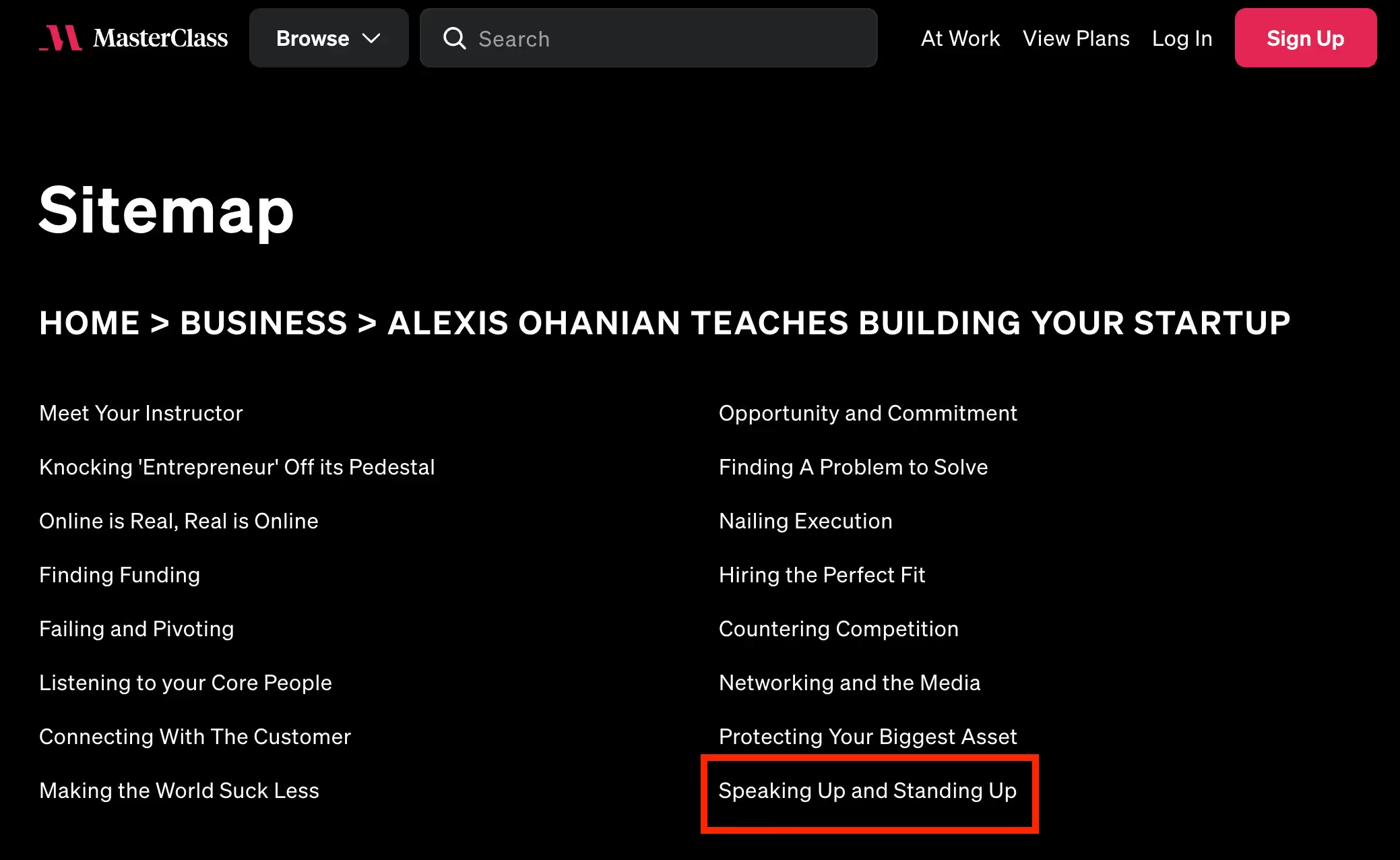
And each page is consistently refreshed with excellent content that offers value and generates organic traffic for Masterclass:

Their success comes from treating content refresh as a strategic initiative, not just a maintenance task.
By systematically improving their existing content, they maintain their authority while continuously improving user experience and search performance.
Masterclass has many other interesting ways to scale content, also including editorial at scale, which we will get to shortly. (get your own free AI Custom Growth Strategy, here).
Here is a recommendation to optimize existing content, akin to a content refresh:

Implementation Framework for Content Refresh
A successful content refresh strategy requires the following workflow:
Step 1: Find Your High-Impact Opportunities
Use Google Search Console to identify pages ranking on positions 5-10 and content with high impressions but low click-through rates. Compare these pages against top-ranking competitors to spot specific content gaps worth updating. After combing through these opportunities, you can find pages ranking in the 10-20 position, if you are a smaller site, and still see outsized gains that can make a big impact.
Step 2: Research Current Search Intent
Study the current top 10 results for your target keywords, noting their structure, depth, and any new subtopics they cover. Pay special attention to how they present information, as this reveals what users now expect to find.
Step 3: Make Strategic Updates
Update your highest-potential pages with current statistics, missing subtopics, and improved structure based on your competitive research. Track the impact of each refresh in your analytics to guide future updates and prove ROI.
Scaling Strategy #3: Editorial at Scale to Build Authority Through Expertise
The editorial approach focuses on creating high-quality, expert-driven content systematically. This strategy works particularly well for companies with deep subject matter expertise or unique industry insights.
Is Editorial Scaling the Right Play for You?
Editorial scaling works best when your competitive advantage comes from deep expertise. You're a perfect candidate if you have strong subject matter experts, unique industry insights, or valuable proprietary knowledge that can be systematically shared.
This approach requires a clear understanding of your audience's needs and the resources to maintain high quality while increasing volume.
How to Do Editorial Scaling Right
Success with editorial scaling means building systems that maintain quality at higher volumes. Start by documenting your internal expertise and creating clear processes for expert collaboration. Then, develop strong editorial workflows that combine AI and automation where helpful.
Focus on creating content frameworks that help you maintain consistency while allowing for deep insights. Most importantly, build quality control systems that ensure every piece meets your standards.
Example: T3 Automates Content and Accelerates Launches
T3 Services Group transformed their content creation process with AI and automation, reducing costs by 90% while improving quality. They solved the challenge of scaling website content production for multiple home services clients by automating their editorial workflow with AI assistance.
This lead to:
- Cut website launch time from 8 weeks to under 1 month
- Reduced service page creation from 2 weeks to 3-4 days
- Accelerated blog content creation from 4-8 weeks to just 4 days
- Decreased per-page creation time from 60+ minutes to 8 minutes
T3's success in scaling their editorial process was built on integrating AI workflows with existing SEO tools like Semrush and WordPress, while implementing automated formatting and HTML generation.
They created custom workflows for different content types and maintained expert oversight while automating repetitive tasks, ensuring quality remained high throughout the process.
Read about how T3 cuts content creation costs by 90% and improves content quality
Implementation Requirements for Editorial at Scale
To scale editorial content successfully, you need the following.
Step #1: Research
Research to identify high-value topics through data analysis and SEO insights. Then map each piece to specific stages in your user's journey.
Step #2: Planning
Build a structured content calendar by coordinating with subject matter experts, setting clear deadlines, and aligning topics with business goals. Then, establish clear quality standards by creating templates for brand voice, technical requirements, and content completeness that scale across teams.
Step #3: Writing and Production
Write efficiently by combining AI tools with expert review, using standardized processes that maintain quality while scaling production. Then you can implement a systematic review process where technical experts verify accuracy, editors ensure brand consistency, and analytics track performance.
Building Your Implementation Roadmap
Choosing between programmatic SEO, content refresh, or editorial scaling is just the first step.
Success comes from turning that choice into a systematic plan for growth.
The best performing companies build clear implementation roadmaps that account for their current position, resources, and goals.
The Phases of Scaling Your SEO With AI
Start with a thorough assessment of your current position. Beyond just traffic numbers and rankings, look at user engagement patterns, conversion rates, and content gaps. This baseline understanding helps you set realistic goals and identify quick wins.
Are there parts of your process that can be automated?
If so, begin by automating one small part of your workflow - whether that's research, outline creation, or performance tracking.
Test and refine this process with a small content set before expanding.
Once you've validated the results, gradually introduce automation into other parts of your content pipeline, maintaining quality checks at each stage.
Next, match your chosen strategy to your specific situation.
If you're pursuing programmatic SEO, audit your data assets and technical capabilities.
For content refresh, map your existing content's performance and potential.
With editorial scaling, assess your expert resources and production capacity. Create concrete plans for building any missing capabilities before you begin scaling.
Finally, establish your operational foundation.
This means putting the right systems and processes in place before you start scaling. Build quality control checkpoints, monitoring dashboards, and clear workflows, and set specific metrics for “success”.
Most importantly, establish a scaling rhythm that allows your team and systems to adapt gradually. Scaling up incrementally month over month has a much greater likelihood of success rather than scaling quickly overnight.
Wrapping Up: Your Next Steps To Scaling SEO With AI
Ready to scale your SEO with AI?
Our AI Growth Readiness Assessment goes beyond basic metrics to deliver a comprehensive evaluation of your domain's scaling potential.
You'll receive personalized organic growth strategies, competitive insights, and clear direction on your best scaling opportunities - all tailored to your specific market position and goals. Totally free, created specifically for your URL.
We’re Here to Help 😃
Book a strategy session with our experts who will guide you through your assessment results, help refine your implementation plan, and identify quick wins while setting realistic timelines.
The market advantage gap between companies that scale effectively and those that don't widens every day - let's make sure you're on the right side of that equation!
Win AI Search.
Increase brand visibility across AI search and Google with the only platform taking you from insights to action.
Get the latest on AI content & marketing
Get the latest in growth and AI workflows delivered to your inbox each week
.avif)

